Award of Excellence
Landscape Progress Administration
Hugo Bruley, Student ASLA; Eustacia Brossart, Student ASLA; Kirsten Dahl, Student ASLA;
Jesse Jones, Student ASLA; Clare O’Reilly, Student ASLA and Adrienne Smith, Student ASLA,
College of Environmental Design, UC Berkeley
Faculty Advisor: Marcia McNally
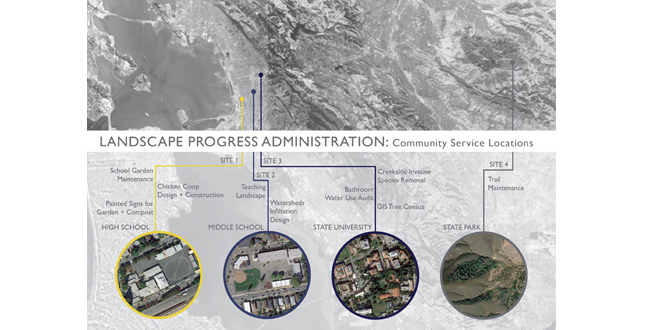 Close Me!
Close Me!Landscape Progress Administration: Community Service Locations
Download Hi-Res ImagePhoto: Kirsten Dahl, Hugo Bruley, Eustacia Brossart, Adrienne Smith, Clare O’Reilly, Jesse Jones, Marcia McNally,
Yu-Chung Li, Pedro PintoPhoto 1 of 14
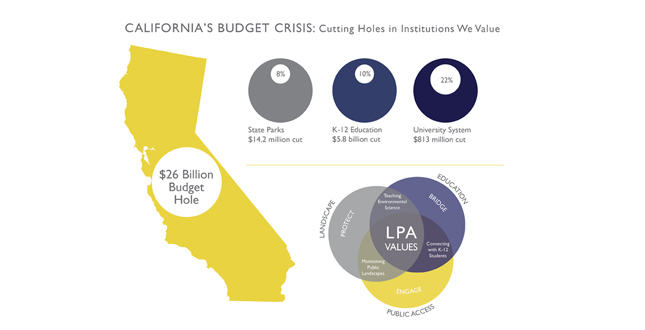 Close Me!
Close Me!California’s Budget Crisis: Cutting Holes in Institutions We Value
Download Hi-Res ImagePhoto: Kirsten Dahl, Hugo Bruley, Eustacia Brossart, Adrienne Smith, Clare O’Reilly, Jesse Jones, Marcia McNally,
Yu-Chung Li, Pedro PintoPhoto 2 of 14
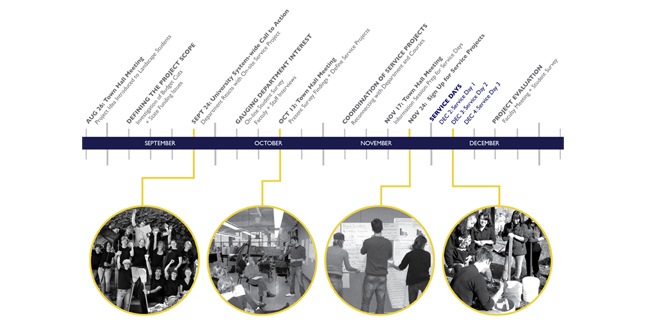 Close Me!
Close Me!Photo: Kirsten Dahl, Hugo Bruley, Eustacia Brossart, Adrienne Smith, Clare O’Reilly, Jesse Jones, Marcia McNally,
Yu-Chung Li, Pedro PintoPhoto 3 of 14
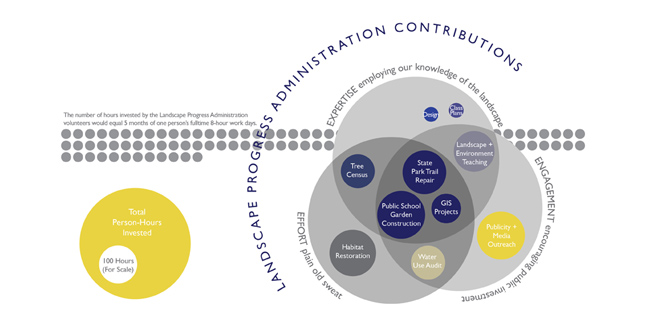 Close Me!
Close Me!The number of hours invested by the Landscape Progress Administration volunteers would equal 5 months of one person’s fulltime 8-hours work days.
Download Hi-Res ImagePhoto: Kirsten Dahl, Hugo Bruley, Eustacia Brossart, Adrienne Smith, Clare O’Reilly, Jesse Jones, Marcia McNally,
Yu-Chung Li, Pedro PintoPhoto 4 of 14
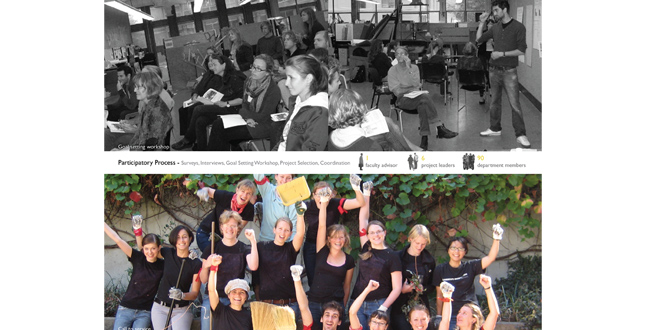 Close Me!
Close Me!Participatory Process: Surveys, Interviews, Goal Setting Workshop, Project Selection, Coordination
Download Hi-Res ImagePhoto: Kirsten Dahl, Hugo Bruley, Eustacia Brossart, Adrienne Smith, Clare O’Reilly, Jesse Jones, Marcia McNally,
Yu-Chung Li, Pedro PintoPhoto 5 of 14
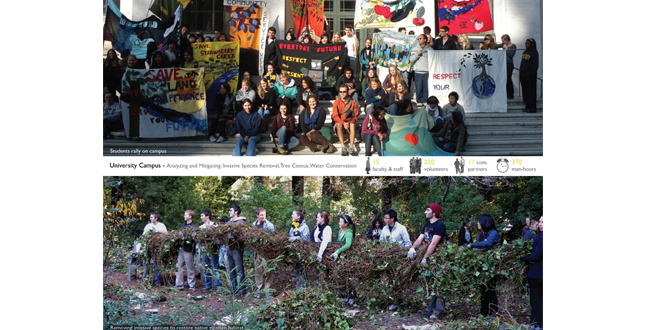 Close Me!
Close Me!University Campus—Analyzing and Mitigating: Invasive Species Removal, Tree Census, Water Conservation.
Download Hi-Res ImagePhoto: Kirsten Dahl, Hugo Bruley, Eustacia Brossart, Adrienne Smith, Clare O’Reilly, Jesse Jones, Marcia McNally,
Yu-Chung Li, Pedro PintoPhoto 6 of 14
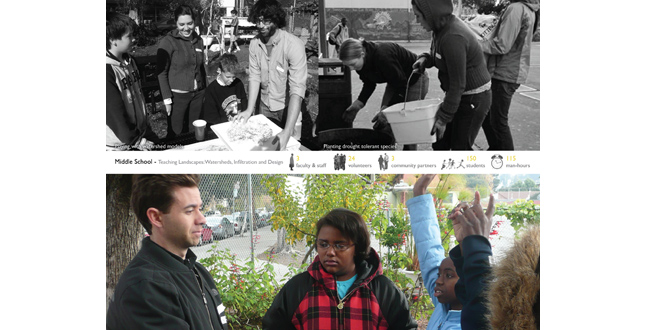 Close Me!
Close Me!Middle School—Teaching Landscapes: Watersheds, Infiltration and Design.
Download Hi-Res ImagePhoto: Kirsten Dahl, Hugo Bruley, Eustacia Brossart, Adrienne Smith, Clare O’Reilly, Jesse Jones, Marcia McNally,
Yu-Chung Li, Pedro PintoPhoto 7 of 14
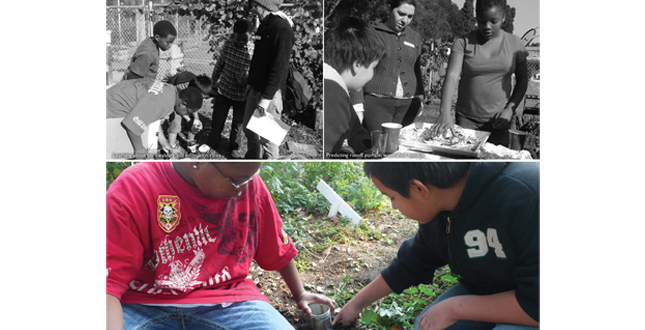 Close Me!
Close Me!Upper Left: Learning about permeability and infiltration rates. Upper right: Predicting runoff paths in watershed models.
Download Hi-Res ImagePhoto: Kirsten Dahl, Hugo Bruley, Eustacia Brossart, Adrienne Smith, Clare O’Reilly, Jesse Jones, Marcia McNally,
Yu-Chung Li, Pedro PintoPhoto 8 of 14
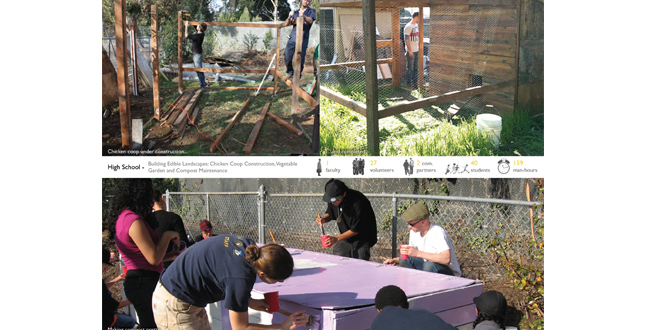 Close Me!
Close Me!High School—Building Edible Landscapes: Chicken Coop Construction, Vegetable Garden and Compost Maintenance.
Download Hi-Res ImagePhoto: Kirsten Dahl, Hugo Bruley, Eustacia Brossart, Adrienne Smith, Clare O’Reilly, Jesse Jones, Marcia McNally,
Yu-Chung Li, Pedro PintoPhoto 9 of 14
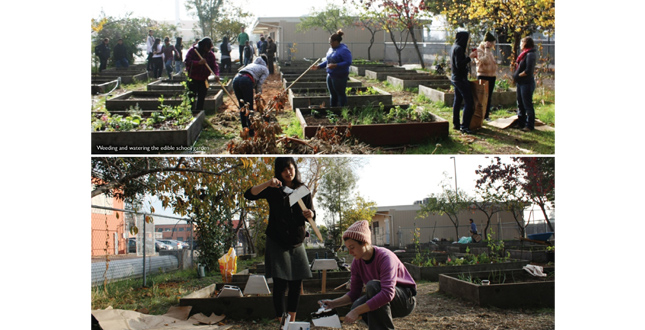 Close Me!
Close Me!Top: Weeding and watering the edible school garden. Bottom: Painting signs for this year’s crops.
Download Hi-Res ImagePhoto: Kirsten Dahl, Hugo Bruley, Eustacia Brossart, Adrienne Smith, Clare O’Reilly, Jesse Jones, Marcia McNally,
Yu-Chung Li, Pedro PintoPhoto 10 of 14
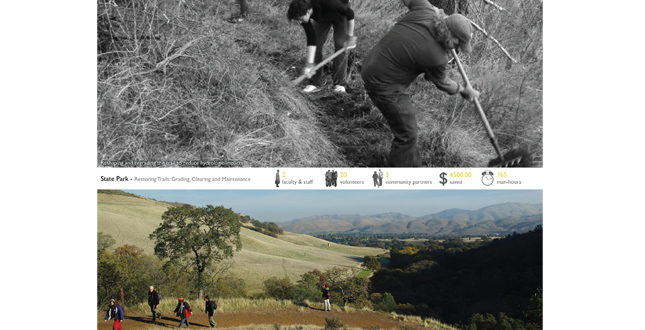 Close Me!
Close Me!State Park—Restoring Trails: Grading, Clearing and Maintenance.
Download Hi-Res ImagePhoto: Kirsten Dahl, Hugo Bruley, Eustacia Brossart, Adrienne Smith, Clare O’Reilly, Jesse Jones, Marcia McNally,
Yu-Chung Li, Pedro PintoPhoto 11 of 14
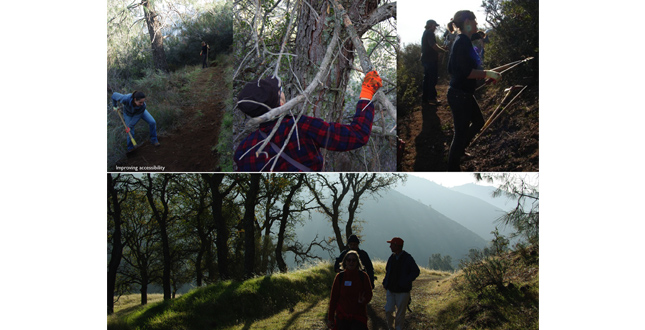 Close Me!
Close Me!Improving Accessibility.
Download Hi-Res ImagePhoto: Kirsten Dahl, Hugo Bruley, Eustacia Brossart, Adrienne Smith, Clare O’Reilly, Jesse Jones, Marcia McNally,
Yu-Chung Li, Pedro PintoPhoto 12 of 14
 Close Me!
Close Me!Community Response—Thank you notes from schools.
Download Hi-Res ImagePhoto: Kirsten Dahl, Hugo Bruley, Eustacia Brossart, Adrienne Smith, Clare O’Reilly, Jesse Jones, Marcia McNally,
Yu-Chung Li, Pedro PintoPhoto 13 of 14
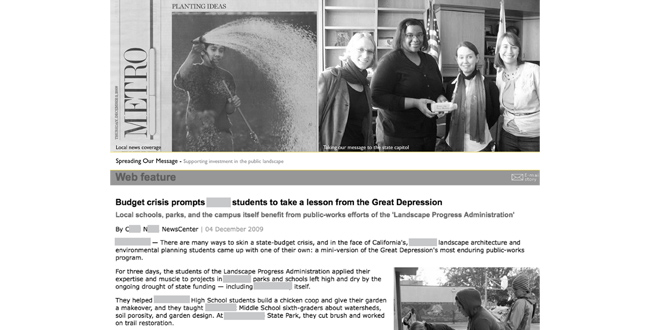 Close Me!
Close Me!Spreading Our Message—Supporting investment in the public landscape.
Download Hi-Res ImagePhoto: Kirsten Dahl, Hugo Bruley, Eustacia Brossart, Adrienne Smith, Clare O’Reilly, Jesse Jones, Marcia McNally,
Yu-Chung Li, Pedro PintoPhoto 14 of 14
Project Statement
In the wake of California’s 2009 budget crisis, funding was slashed to public programs across the state. As we saw staff and faculty furloughed and student services threatened in our own department, we took action. Our student group led a participatory process to reach out to public schools and parks similarly impacted by the budget cuts. Dubbing ourselves the Landscape Progress Administration, our department volunteered both time and expertise in support of public landscapes.
Project Narrative
In 2009, the California state legislature slashed the public higher education budget by $2 billion as part of a package of cuts to close the $26 billion state budget gap. This led to layoffs and graduated furloughs for all faculty and staff within our university, resulting in fewer teaching days during the Fall 2009 semester, while our college budget suffered a 16% cut this year with deeper cuts promised next year. Landscape architecture department members were also disturbed by the decline in state funding for places important to our profession, such as public parks and open spaces, as well as cuts suffered by the entire public school system.
In response, landscape architecture students, faculty, and staff initiated a constructive effort to mitigate and draw attention to the impacts of state-funding shortfalls on public landscapes and schools. Under the banner of the Landscape Progress Administration, our department took advantage of university mandated furlough days to volunteer our time and expertise at a state park, public schools, and around our campus in an effort to make a difference within public landscapes and institutions that are facing similar state funding cuts.
The idea for a service-based response was introduced at a town hall meeting on the first day of classes, during which our department chair proposed using the furlough days at the end of the semester for volunteer service. Students, faculty, and staff voted enthusiastically in favor of carrying out community service projects, and agreed that the organization and implementation of the project should be student-led. We volunteered to facilitate the project as part of our coursework for our citizen participation in community design and planning class.
During the semester, we met with department members to determine goals to be achieved through project implementation, selected appropriate volunteer projects, and organized implementation. The first step was the “Courtyard Call to Service.” To make the connection between budget cuts and the need for community service action, we organized students in our department to clean up, weed, and prune a neglected courtyard adjacent to our college’s building to coincide with a statewide walkout protesting the state’s disinvestment in the public university system. After we introduced the service project concept, we conducted a student survey and interviewed faculty and staff to gather information about their priorities and project ideas. At a series of department-wide town hall meetings, we presented survey and interview results, set goals, and compiled a list of public landscapes and organizations that were also hit hard by state budget cuts and could use help from our department. During one meeting, students, faculty and staff voted to name the project the Landscape Progress Administration. By referencing the New Deal’s Works Progress Administration, students sought to bring attention to hard times — including unemployment at its highest rate since the Great Depression — and to call for a civic-minded spirit of public investment that we believe is currently lacking in our state.
Through the participatory process, and working with staff on campus and at other public institutions, we selected several service projects. Some projects were specific to the curriculum and skills of a particular course, and some were open to the entire department and other willing volunteers from outside the department. During the final week of the semester, over three hundred students, faculty, and staff volunteered their time.
Students of the Sustainable Landscapes and Cities class made ornate banners to display at each project site, promoting awareness of environmental issues, landscape architecture, community service, and civic investment. Other students undertook research and maintenance projects on our university campus. To compensate for lost staff time in the campus creek restoration program, one hundred volunteers removed invasive species from a creek corridor, making space for native riparian species. Eighty students in an introductory environmental design class learned about water conservation and building science through an audit of bathroom fixtures in campus buildings to identify those that consumed too much water. Ecological analysis students conducted a census of campus trees, updating an obsolete map. In addition, several Geographic Information Systems students worked with local community organizations to provide needed mapping and analysis services.
Off campus, students from our department built relationships across educational boundaries by engaging middle and high school students. We developed two days of hands-on curricula for middle school students. Department members taught 6th grade earth science students in their schoolyard, measuring surface permeability and examining the effects of simulated pollution on makeshift watershed models. Volunteers and students from the after-school garden program planted drought-tolerant species on school grounds. Students also introduced the children to the field of landscape architecture and helped them design and draw new plans for their school grounds. Across town at a high school suffering from staff layoffs, twenty-seven department members worked with high school students to build a coop for chickens raised in a biology class, weed and water the neglected edible school garden, create garden signage, and decorate the compost bin with educational messages.
Further afield, twenty-two members of the department worked with four volunteer coordinators to clear, re-grade, prune, and maintain approximately one mile of an overgrown hiking trail in a state park. Steep state funding cuts and the threat of closure forced park staff layoffs and furloughs along with cuts to hours and services. Our labor saved the park $4,500 and provided 165 hours of service.
Public reaction to the Landscape Progress Administration was overwhelmingly positive. Local news media covered some of the projects. The middle and high school students and teachers, the state parks volunteer coordinator, and our campus staff all expressed appreciation and great interest in continuing to work with our department. We conducted a follow-up student survey and discussed the project with faculty. All parties agreed that the volunteer experience was rewarding, and that the department should continue to work with these and similar institutions every year. We then traveled to Sacramento and met with seven state legislature staff members, advocating for greater public investment, both from taxpayers and the state to fund public landscapes and education, and from citizens through volunteering in the landscapes and schools that make our state great. Staff members told us that although the outlook is grim for increased state funding of public education and landscapes, they were delighted with our volunteer work and encouraged us to continue.
Over the course of the semester, we learned a great deal about organizing and managing groups, soliciting community participation in a democratic and iterative process, bridging institutional barriers, and the joy of teaching and volunteering within our valued public landscapes. Plans are currently underway to return to the state park and schools in the fall, and we hope that the Landscape Progress Administration will continue to cultivate relationships, awareness, and civic investment across public institutional boundaries.
Additional Project Credits
The six students listed as official entrants were the Landscape Progress Administration coordinating team, which formed as students in Professor Marcia McNally’s course LA 242: Citizen Participation in the Community Design Process.
We would like to acknowledge contributions from the following:
UC Berkeley Department of Landscape Architecture & Environmental Planning faculty, students and staff, and the Beatrix Farrand Fund
Principal Kenya Crockett, parents David Roach and Michael Napolitano, teachers Jesse Thaler and Taylor White, and participating students from Claremont Middle School
Teacher Sarah Johnson, volunteer Andrew Francis, and participating students from Castlemont Leadership High School
Cathy Moyer of Volunteers for Outdoor California, and trail crew leaders from Mount Diablo State Park
Theron Klos, Grounds Operation Manager at UC Berkeley; Tyler Grinberg, Tim Pine, & Lindsey Sanders of UC Berkeley Strawberry Creek Restoration; Sara Shirazi, Associate Director of Campus Facilities, UC Berkeley
Professor Linda Jewell; Graduate Student Instructors Sara Jensen, Susanne Cowan, Matt Smith, Fiona Cundy, and Huey Ying Hsu; and participating students of ED 1: People and Environmental Design
Professor Randy Hester; Graduate Student Instructors Lauren Stahl and Laura Tepper; and participating students from LA 130: Sustainable Landscapes and Cities
Professor Joe McBride, Graduate Student Instructor Jesse Jones, and participating students of LA 110: Ecological Analysis
Professor John Radke, Graduate Student Instructors Allison Lassiter and Ye Kang Ko, and participating students of LA 188: Geographic Information Systems
Professor Louise Mozingo, Graduate Student Instructor David De La Pena, and participating students of LA 170: History of Landscape Architecture
Sources for information about California’s budget presented in the narrative and diagrams are from the following articles:
Budget crisis forces deep cuts at Calif. Schools. (2009, June 22). USA Today.
California Budget Crisis Overview. (2010, January 7). The New York Times.
Cuts in California: How billions in budget cuts will affect the Golden State, Education: K-12 Education, Higher Education. (2009, December 30). The New York Times.
Cuts in California: How billions in budget cuts will affect the Golden State, Miscellaneous: State Parks. (2009, December 30). The New York Times.
Gore, Erin S. (2010, February 2). UC Berkeley Financial Overview presentation to the Berkeley division of the Academic Senate.
Thomas, Pete. (2009, September 25). California’s state parks spared from closure, but how fantastic is this plan? Los Angeles Times.
Media coverage sources:
Cameron, D Ross/ Staff Photos. “Planting Ideas.” Oakland Tribune. 12/3/09: A3
Ness, Carol. “Budget crisis prompts LAEP students to take a lesson from the Great Depression,” UC Berkeley News Center. 12/4/09:
Aerial images in the site plan were captured using the following:
“East Bay, California.” 37°54’08.92”N and 122°09’10.88”W. Google Earth. Imagery date October 2, 2009. Accessed May 24, 2010.





